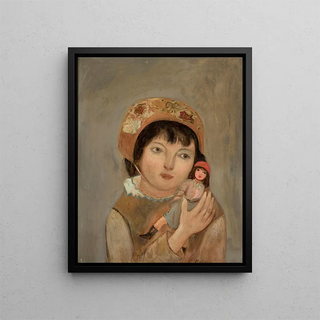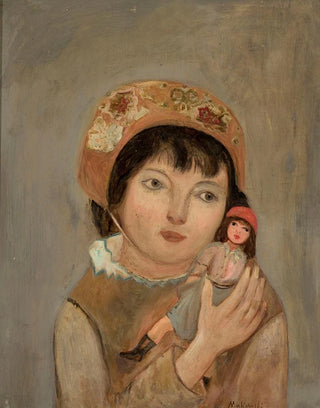Art print | Petite fille avec une poupée - Tadeusz Makowski


View from behind

Frame (optional)
In the rich and diverse universe of art, some works manage to capture the very essence of childhood, blending innocence and melancholy. The "Petite fille avec une poupée" by Tadeusz Makowski is a perfect example. This piece, imbued with poignant delicacy, transports us to a world where the simplicity of gestures and emotions combines with rare depth. Through the gaze of this young girl, the artist invites us to explore the subtleties of the human soul, while evoking a sense of nostalgia. The art print of this work allows us to rediscover the beauty of childhood and appreciate Makowski's technical mastery, which succeeds in infusing life and emotion into his subjects.
Style and uniqueness of the work
Tadeusz Makowski's style is distinguished by a subtle harmony between figurative and abstract elements. In "Petite fille avec une poupée," the forms are simplified, almost stylized, but this does not diminish the evocative power of the piece. The colors, soft and pastel, create a calming atmosphere, while the fluid lines bring a lightness to the composition. The young girl, with an expressive face, seems to delve into her thoughts, lost in an imaginary world where dolls come to life. Every detail, from the gaze to the posture, tells a story, an introspection on childhood and its dreams. This painting transcends a simple portrait to become a reflection on the fragility of existence and the beauty of childhood memories.
The artist and his influence
Tadeusz Makowski, Polish artist of the early 20th century, knew how to mark his era with a unique approach to painting. Influenced by modernist currents, he developed a style that is entirely his own, combining refined technique with heightened sensitivity. His fascination with childhood and themes of solitude and melancholy is evident in many works. Makowski also interacted with renowned artists, which enriched his creative palette. His artistic legacy endures, inspiring many contemporary artists to explore deep emotions and life stories through art prints.

Matte finish

View from behind

Frame (optional)
In the rich and diverse universe of art, some works manage to capture the very essence of childhood, blending innocence and melancholy. The "Petite fille avec une poupée" by Tadeusz Makowski is a perfect example. This piece, imbued with poignant delicacy, transports us to a world where the simplicity of gestures and emotions combines with rare depth. Through the gaze of this young girl, the artist invites us to explore the subtleties of the human soul, while evoking a sense of nostalgia. The art print of this work allows us to rediscover the beauty of childhood and appreciate Makowski's technical mastery, which succeeds in infusing life and emotion into his subjects.
Style and uniqueness of the work
Tadeusz Makowski's style is distinguished by a subtle harmony between figurative and abstract elements. In "Petite fille avec une poupée," the forms are simplified, almost stylized, but this does not diminish the evocative power of the piece. The colors, soft and pastel, create a calming atmosphere, while the fluid lines bring a lightness to the composition. The young girl, with an expressive face, seems to delve into her thoughts, lost in an imaginary world where dolls come to life. Every detail, from the gaze to the posture, tells a story, an introspection on childhood and its dreams. This painting transcends a simple portrait to become a reflection on the fragility of existence and the beauty of childhood memories.
The artist and his influence
Tadeusz Makowski, Polish artist of the early 20th century, knew how to mark his era with a unique approach to painting. Influenced by modernist currents, he developed a style that is entirely his own, combining refined technique with heightened sensitivity. His fascination with childhood and themes of solitude and melancholy is evident in many works. Makowski also interacted with renowned artists, which enriched his creative palette. His artistic legacy endures, inspiring many contemporary artists to explore deep emotions and life stories through art prints.






